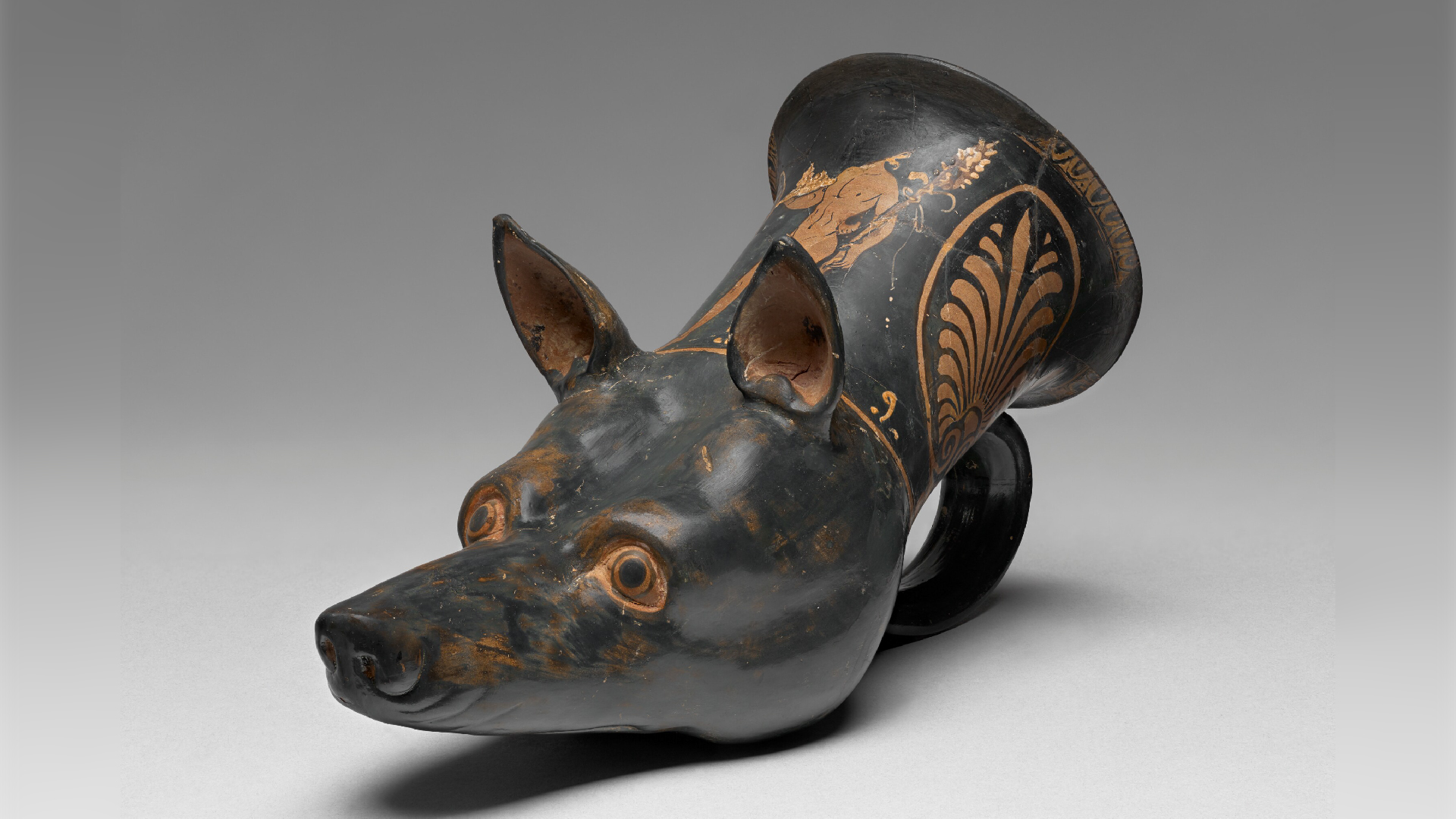Ancient Art Meets Revelry: The 2,300-Year-Old Spartan Hound Rhyton That Elevated Ancient Drinking Parties
 The remarkably preserved Apulian dog head rhyton, showcasing intricate craftsmanship from 340-330 B.C. (Image credit: The Getty, CC0 1.0)
The remarkably preserved Apulian dog head rhyton, showcasing intricate craftsmanship from 340-330 B.C. (Image credit: The Getty, CC0 1.0)
The Ancient Art of Drinking in Style
In today’s world of mass-produced glassware and disposable cups, it’s easy to forget that drinking vessels were once works of art that reflected cultural values, artistic traditions, and social practices. The Apulian dog head rhyton—a masterpiece of ancient craftsmanship dating back to the 4th century B.C.—represents not just an artistic achievement but a fascinating window into the intersection of Greek and Italian cultures, religious practices, and social customs of the ancient world.
This terracotta drinking vessel, crafted to resemble the head of a now-extinct Laconian hound (also known as a Spartan hound), is a testament to the sophisticated artistic exchange that occurred in southern Italy over two millennia ago. Discovered in the “heel” of Italy’s geographical “boot” in the region of Puglia, this remarkable artifact demonstrates how deeply Greek culture influenced Italian art and society during what historians call the Magna Graecia period.
A Masterpiece with a Pedigree
The rhyton currently housed at the Getty Museum in Los Angeles is believed to have originated from the workshop of the renowned “Darius Painter”—a modern name given to an anonymous but highly skilled artisan whose distinctive vase-painting style was celebrated throughout Puglia. This particular artist was especially productive between 340 and 320 B.C., during which time they created numerous ceramic works that showcased exceptional detail and artistry.
Measuring approximately 8 by 4 inches (20 by 10 centimeters), this drinking vessel exhibits remarkable craftsmanship. The majority of the rhyton is covered in a sleek black glaze, with strategic exceptions for the dog’s ears and nostrils, which were left in the natural terracotta color to create visual contrast. The dog’s expressive eyes are rendered with a diluted glaze, giving them a lifelike appearance that has survived for over two millennia.
The upper bowl portion of the cup features even more artistic elements: a satyr—a mythological half-man, half-goat creature associated with woodland revelry—is depicted holding a plate and staff. This central figure is surrounded by decorative leaf patterns and egg-shaped designs that demonstrate the artisan’s attention to detail and mastery of Greek decorative motifs.
The Symbolic Significance of the Laconian Hound
The choice to craft this rhyton in the shape of a Laconian hound was far from arbitrary. This breed originated in Laconia, the region of ancient Greece where the powerful city-state of Sparta was located. The Laconian hound was renowned throughout the ancient Mediterranean world for its exceptional hunting abilities, keen sense of smell, and loyalty—qualities that made it a frequent subject in various art forms.
The extinct breed appeared on numerous Greek mosaics, gravestones, and, as exemplified by this artifact, drinking vessels. By incorporating this specific canine into functional art, the creator was making a deliberate reference to Greek culture and possibly even to the qualities associated with these prestigious hunting dogs: nobility, skill, and loyalty.
Form Follows Function: The Unique Design of Rhytons
What makes rhytons particularly fascinating from both a cultural and functional perspective is their distinctive design. Unlike standard cups or goblets, rhytons did not have flat bottoms, meaning they could not be conventionally set down on a table while containing liquid. This seemingly impractical design feature actually served important social and ritual purposes.
The rhyton’s design likely evolved from earlier drinking horns that were common throughout Eurasia during the Bronze Age (roughly the second millennium B.C.). However, Greek artisans transformed this utilitarian form into something more sophisticated by incorporating elaborate decorations and mythological imagery.
The presence of a satyr on this particular rhyton is especially significant, as satyrs were powerful symbols of debauchery, drunkenness, and uninhibited celebration in Greek mythology. They were companions to Dionysus, the god of wine and ecstasy, making them particularly appropriate decorations for drinking vessels meant to be used in festive contexts.
Beyond Mere Drinking: Ceremonial Functions
While rhytons certainly featured prominently at symposia (formal Greek drinking parties) and other social gatherings, archaeological evidence suggests they also served important ceremonial purposes. These vessels may have been used to pour libations—ritual offerings of wine, oil, or even blood—particularly during animal sacrifices and religious ceremonies.
The dual nature of these vessels—as both practical drinking cups and ceremonial implements—speaks to the blending of everyday life and religious practice in ancient Mediterranean cultures. What might appear to modern eyes as simply an elaborate cup was, in its time, an object that could transition seamlessly between secular celebration and sacred ritual.
A Testament to Cultural Exchange: Greece and Magna Graecia
Perhaps one of the most significant aspects of this Apulian rhyton is what it reveals about cultural exchange in the ancient Mediterranean. The discovery of this Greek-style artifact in southern Italy is not surprising to archaeologists and historians familiar with the region’s history. From the 8th century B.C. onward, Greek colonists established numerous settlements throughout southern Italy and Sicily, creating what Romans would later call “Magna Graecia” or “Greater Greece.”
These Greek colonies maintained strong cultural, economic, and artistic ties with their motherland while simultaneously developing their own distinctive traditions through interaction with local Italian peoples. The Apulian rhyton exemplifies this cultural fusion: Greek in its form and much of its decoration, but produced in what is now Italy, possibly by artisans who were themselves of mixed Greek-Italian heritage.
The Magna Graecia region maintained its Greek cultural identity even as other parts of Italy fell under Roman influence. It wasn’t until 205 B.C., more than a century after this rhyton was created, that the Romans finally annexed the area, incorporating it into their expanding empire.
The Broader Context: Animal-Shaped Rhytons
While this particular rhyton takes the form of a Laconian hound, ancient artisans created rhytons depicting a remarkable variety of animals. Archaeological discoveries have revealed rhytons shaped like horses, stags, cats, rams, boars, and lions. Some even depicted mythical creatures like griffins, demonstrating how these vessels could bridge the gap between the natural world and the supernatural realm that featured prominently in ancient belief systems.
The choice of animal was rarely random. Different creatures carried different symbolic associations, and the selection of a particular animal form might reflect the vessel’s intended use, the status of its owner, or references to specific deities and their sacred animals.
Preservation and Modern Significance
The survival of this delicate terracotta rhyton for over 2,300 years is remarkable in itself. Unlike more durable materials like stone or metal, fired clay is relatively fragile, especially when shaped into elaborate forms with protruding elements like the dog’s ears. The excellent preservation of this piece, including its painted decorations, suggests it may have been carefully interred in a tomb or otherwise protected from the elements and human activity for much of its existence.
Today, the Apulian dog head rhyton serves as more than just a beautiful museum piece. For archaeologists, art historians, and cultural anthropologists, it provides invaluable insights into ancient manufacturing techniques, artistic conventions, trade networks, and social practices. For the general public, it offers a tangible connection to people who lived, celebrated, and worshipped more than two millennia ago—people who, like us, appreciated beauty, craftsmanship, and the pleasures of sharing drinks with friends.
Conclusion: A Cup That Holds History
The Apulian dog head rhyton stands as a testament to ancient Mediterranean artistry, cross-cultural exchange, and the sophisticated integration of functionality and symbolism in everyday objects. When we look at this remarkable vessel today, we’re not just seeing an elaborate drinking cup—we’re glimpsing the social gatherings where it might have been passed from hand to hand, the religious ceremonies where it might have poured offerings to the gods, and the skilled artisans who shaped and painted it with such care.
In an age of disposable consumer goods, there’s something profoundly moving about objects like this—items created with such skill that they were treasured in their time and continue to captivate us thousands of years later. The rhyton reminds us that the objects we create and use can transcend their immediate practical purpose to become carriers of cultural memory and artistic achievement that span millennia.
Whether used for ceremonial libations or simply as an impressive drinking vessel at ancient parties, this 2,300-year-old rhyton continues to tell its story—a story of cultural exchange, artistic excellence, and the timeless human desire to transform even everyday objects into things of beauty and meaning.



Bet thủ khi đặt cược tại nhà cái sẽ có khả năng khám phá ưu điểm nổi bật mà slot365 link sở hữu, tạo nên điểm khác biệt so với sân chơi khác trên thị trường. Điểm thú vị đầu tiên là bạn hoàn toàn được tham gia săn thưởng tại nhiều sảnh cược cùng lúc. Anh em hoàn toàn có thể lựa chọn đặt cược tại sảnh casino và theo dõi trực tiếp các trận đấu thể thao thú vị cùng một lúc.